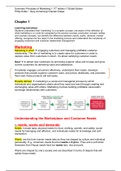Summary Principles of Marketing // 17th edition // Global Edition
Philip Kotler * Gary Armstrong// Daniek Dreijer
Chapter 1
Learning outcomes:
Students understand that “marketing” is a complex concept, are aware of the definition of
what marketing is or could be compared to the product concept, production concept, selling
and societal concepts, can identify the difference between needs, wants, demand, market
offering, recognise the five steps in the marketing process and understand the complexity of
engaging customers and customer relationship management.
Marketing
Marketing in short engaging customers and managing profitable customer
relationship. The aim of marketing is to create value for customers in order to
capture value from customers in return. It’s about satisfying customer needs.
Goal to attract new customers by promising superior value and to keep and grow
current customers by delivering value and satisfaction.
If marketer engages consumers effectively, understand their needs, develops
products that provide superior customer value, and prices, distributes, and promotes
them well, these products will sell easily.
Broadly defined marketing is a social and managerial process by which
individuals and organisations obtain what they need and want through creating and
exchanging value with others. Marketing involves building profitable value-laden
exchange relationships with customers.
Understanding the Marketplace and Customer Needs
1: needs, wants and demands
Needs: Include basic physical needs for food, clothing, warmth, and safety; social
needs for belonging and affection, and individuals needs for knowledge and self-
expression.
Wants: are the form human needs take as they are shaped by culture and individual
personality. E.g., American needs food but wants a BigMac, Fries and a soft drink/
Someone from Papua needs food but wants taro, rice and pork.
Wants are shaped by one’s society and are described in terms of objects that will
satisfy those needs.
,Summary Principles of Marketing // 17th edition // Global Edition
Philip Kotler * Gary Armstrong// Daniek Dreijer
Demands: wants becomes demands when backed by buying power. People demand
products and services with benefits that add up to the most value and satisfaction.
,Summary Principles of Marketing // 17th edition // Global Edition
Philip Kotler * Gary Armstrong// Daniek Dreijer
2: market offerings (products, services, and experiences)
Market offerings combination of products, services, information, or experiences
offered to a market to satisfy a need or want. Market offers are not limited to physical
products. // market offerings include other entities, such as persons, places,
organisations, information, and ideas.
services activities or benefits offered for sale that are essentially intangible and do
not result in the ownership of anything.
(E.g., banking, airline, hotel, retailing, and home repair service.)
Marketing myopia when sellers make the mistake of paying more attention to the
specific product, they offer than to the benefits and experiences produced by these
products. They lose sight of the underlying customer needs.
e.g., the manufacturer of quarter-inch drill bits may think that the customer needs a drill bit but what the customer
really needs is a quarter-inch hole. The seller will have trouble if a new product comes along that serves the
customer’s need better or less expensively. The customer will have the same need but will want the new product.
brand experiences when marketers look beyond the attributes of the products and
services they sell and orchestrating several services and products.
(rangschikken)
e.g., you don’t just visit Disney World Resort; you immerse yourself and your family in a world of wonder where
dreams come true.
3: value and satisfaction
Customers form expectations about the value and satisfaction that various market
offering will deliver and buy accordingly. Satisfied customers buy again and tell
others about their good experiences. Dissatisfied customers switch to competitors.
When marketers set the expectations;
Too low they might satisfy customers who buy but fail to attract enough buyers.
Too high buyers will be disappointed.
4: exchanges and relationships
marketing occurs when people decide to satisfy their needs and wants through
exchange relationships. Exchange the act of obtaining a desired object of
someone by offering something in return. In other words, the marketer tries to bring
about a response to some market offerings. may be more than simply buying or
trading products and services.
E.g., political candidate wants votes,
church wants memberships and participations,
an orchestra wants an audience.
, Summary Principles of Marketing // 17th edition // Global Edition
Philip Kotler * Gary Armstrong// Daniek Dreijer
5: markets
Market a set of actual and potential buyers of a product or service. These buyers
share a particular need or want that can be satisfied through exchange relationships.
Marketing means managing markets to bring about profitable customer relationships.
~~ The arrows represent relationships that must be developed and managed ~~
Each party in the system is affected by Major environmental forces demographic,
economic, natural, technological, political, and social/cultural.
A company’s success at engaging customers and building profitable relationships
depends not only in its own action but also on how well the entire system serves the
needs of final customers.
e.g., Walmart cannot fulfil its promise of low prices unless its suppliers provide merchandise at low
costs.
Designing a customer Value-Driven Marketing Strategy and
Plan
Marketing management the art and science of choosing target markets and
building profitable relationships with them.
Aim: to engage, keep and grow target customers by creating, delivering, and
communicating superior customer value.
2 important questions:
1. What customers will we serve (what’s our target market)?
2. How can we serve these customers best (what’s our value proposition)?
Selecting customers to serve
Company must decide whom it will serve by:
Market segmentation dividing the market into segments of customers.
Target marketing selecting which segments it will go after.






